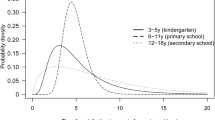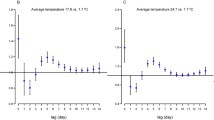Abstract
Epidemics of hand, foot, and mouth disease (HFMD) have been emerging and reemerging in recent years. This study aims to investigate whether breastfeeding and other factors may affect the profile of fever and disease course in children with HFMD. Three hundred seventy-two preschool children with HFMD were included. The demographics, environmental factors, and delivery- and feeding-associated factors in the children were obtained and their effects on the profile of fever and disease course were analyzed. Of the 372 children, 139 (37.37%) had fever during the disease course. Gender, breastfeeding pattern, birth season and gestational age were significantly different between the children with and without fever (p = 0.034, p < 0.0001, p = 0.035 and p = 0.013, respectively). After multivariate-adjusted analysis, prolonged exclusive breastfeeding (p = 0.001, OR 0.401, 95% CI 0.229–0.704), autumn birth (p = 0.007, OR 0.409, 95% CI 0.214–0.784) and higher gestational age (p = 0.029, OR 0.089, 95% CI 0.010–0.781) were protective factors for the incidence of fever.
Similar content being viewed by others
References
Wong SS, Yip CC, Lau SK, Yuen KY (2010) Human enterovirus 71 and hand, foot and mouth disease. Epidemiol Infect 138:1071–1089
Ho M, Chen ER, Hsu KH, Twu SJ, Chen KT, Tsai SF, Wang JR, Shih SR (1999) An epidemic of enterovirus 71 infection in Taiwan. Taiwan Enterovirus Epidemic Working Group. N Engl J Med 341:929–935
Chang LY, Lin TY, Hsu KH, Huang YC, Lin KL, Hsueh C, Shih SR, Ning HC, Hwang MS, Wang HS, Lee CY (1999) Clinical features and risk factors of pulmonary oedema after enterovirus-71-related hand, foot, and mouth disease. Lancet 354:1682–1686
Richardson HB Jr, Leiboritz A (1965) “Hand, foot, and mouth disease” in children; an epidemic associated with Coxsakie virus A-16. J Pediatr 67:6–12
Ishimaru Y, Nakano S, Yamaoka K, Takami S (1980) Outbreaks of hand, foot, and mouth disease by enterovirus 71. High incidence of complication disorders of central nervous system. Arch Dis Child 55:583–588
Grist NR, Bell EJ, Assaad F (1978) Enteroviruses in human disease. Prog Med Virol 24:114–157
Ooi EE, Phoon MC, Ishak B, Chan SH (2002) Seroepidemiology of human enterovirus 71, Singapore. Emerg Infect Dis 8:995–997
Ding NZ, Wang XM, Sun SW, Song Q, Li SN, He CQ (2009) Appearance of mosaic enterovirus 71 in the 2008 outbreak of China. Virus Res 145:157–161
Huang SW, Hsu YW, Smith DJ, Kiang D, Tsai HP, Lin KH, Wang SM, Liu CC, Su IJ, Wang JR (2009) Reemergence of enterovirus 71 in 2008 in Taiwan: dynamics of genetic and antigenic evolution from 1998 to 2008. J Clin Microbiol 47:3653–3662
Ma E, Chan KC, Cheng P, Wong C, Chuang SK (2010) The enterovirus 71 epidemic in 2008—public health implications for Hong Kong. Int J Infect Dis 14:e775–e780
Tan X, Huang X, Zhu S, Chen H, Yu Q, Wang H, Huo X, Zhou J, Wu Y, Yan D, Zhang Y, Wang D, Cui A, An H, Xu W (2011) The persistent circulation of enterovirus 71 in People’s Republic of China: causing emerging nationwide epidemics since 2008. PLoS One 6:e25662
Wang JF, Guo YS, Christakos G, Yang WZ, Liao YL, Li ZJ, Li XZ, Lai SJ, Chen HY (2011) Hand, foot and mouth disease: spatiotemporal transmission and climate. Int J Health Geogr 10:25
Zhang J, Sun J, Chang Z, Zhang W, Wang Z, Feng Z (2011) Characterization of hand, foot, and mouth disease in China between 2008 and 2009. Biomed Environ Sci 24:214–221
Wang Y, Feng Z, Yang Y, Self S, Gao Y, Longini IM, Wakefield J, Zhang J, Wang L, Chen X, Yao L, Stanaway JD, Wang Z, Yang W (2011) Hand, foot, and mouth disease in china: patterns of spread and transmissibility. Epidemiology 22:781–792
Ruan F, Yang T, Ma H, Jin Y, Song S, Fontaine RE, Zhu BP (2011) Risk factors for hand, foot, and mouth disease and herpangina and the preventive effect of hand-washing. Pediatrics 127:e898–e904
Kramer MS (1988) Infant feeding, infection, and public health. Pediatrics 81:164–166
Oddy WH, Robinson M, Kendall GE, Li J, Zubrick SR, Stanley FJ (2011) Breastfeeding and early child development: a prospective cohort study. Acta Paediatr 100:992–999
Quinn PJ, O’Callaghan M, Williams GM, Najman JM, Andersen MJ, Bor W (2001) The effect of breastfeeding on child development at 5 years: a cohort study. J Paediatr Child Health 37:465–469
Oddy WH, Li J, Whitehouse AJ, Zubrick SR, Malacova E (2011) Breastfeeding duration and academic achievement at 10 years. Pediatrics 127:e137–e145
Whitehouse AJ, Robinson M, Li J, Oddy WH (2011) Duration of breast feeding and language ability in middle childhood. Paediatr Perinat Epidemiol 25:44–52
James DC, Lessen R (2009) American Dietetic Association. Position of the American Dietetic Association: promoting and supporting breastfeeding. J Am Diet Assoc 109:1926–1942
Jenista JA, Powell KR, Menegus MA (1984) Epidemiology of neonatal enterovirus infection. J Pediatr 104:685–690
Sadeharju K, Knip M, Virtanen SM, Savilahti E, Tauriainen S, Koskela P, Akerblom HK, Hyöty H (2007) Finnish TRIGR Study Group. Maternal antibodies in breast milk protect the child from enterovirus infections. Pediatrics 119:941–946
Witsø E, Cinek O, Aldrin M, Grinde B, Rasmussen T, Wetlesen T, Rønningen KS (2010) Predictors of sub-clinical enterovirus infections in infants: a prospective cohort study. Int J Epidemiol 39:459–468
Ministry of Health of the People’s Republic of China (2010) Hand, Foot and Mouth Disease Clinic Guide (2010 edition). Available at: http://www.moh.gov.cn/publicfiles/business/htmlfiles/mohyzs/s3586/201004/46884.htm. (in Chinese) Accessed 19 January 2012.
Sacker A, Quigley MA, Kelly YJ (2006) Breastfeeding and developmental delay: findings from the millennium cohort study. Pediatrics 118:e682–e689
Pisacane A, Continisio P, Palma O, Cataldo S, De Michele F, Vairo U (2010) Breastfeeding and risk for fever after immunization. Pediatrics 125:e1448–e1452
Chapman DJ (2010) Breastfeeding associated with a lower risk for fever following immunization. J Hum Lact 26:450–451
López-Alarcón M, Garza C, Habicht JP, Martínez L, Pegueros V, Villalpando S (2002) Breastfeeding attenuates reductions in energy intake induced by a mild immunologic stimulus represented by DPTH immunization: possible roles of interleukin-1beta, tumor necrosis factor-alpha and leptin. J Nutr 132:1293–1298
Anderson AK (2009) Association between infant feeding and early postpartum infant body composition: a pilot prospective study. Int J Pediatr 2009:648091
Collinson AC, Ngom PT, Moore SE, Morgan G, Prentice AM (2008) Birth season and environmental influences on blood leucocyte and lymphocyte subpopulations in rural Gambian infants. BMC Immunol 9:18
Gazala E, Ron-Feldman V, Alterman M, Kama S, Novack L (2006) The association between birth season and future development of childhood asthma. Pediatr Pulmonol 41:1125–1128
van Baar AL, van Wassenaer AG, Briët JM, Dekker FW, Kok JH (2005) Very preterm birth is associated with disabilities in multiple developmental domains. J Pediatr Psychol 30:247–255
Ballow M, Cates KL, Rowe JC, Goetz C, Desbonnet C (1986) Development of the immune system in very low birth weight (less than 1500 g) premature infants: concentrations of plasma immunoglobulins and patterns of infections. Pediatr Res 20:899–904
Strunk T, Currie A, Richmond P, Simmer K, Burgner D (2011) Innate immunity in human newborn infants: prematurity means more than immaturity. J Matern Fetal Neonatal Med 24:25–31
Resch B, Paes B (2011) Are late preterm infants as susceptible to RSV infection as full term infants? Early Hum Dev 87(Suppl 1):S47–S49
Carbonell-Estrany X, Quero J, Bustos G, Cotero A, Doménech E, Figueras-Aloy J, Fraga JM, García LG, García-Alix A, Del Río MG, Krauel X, Sastre JB, Narbona E, Roqués V, Hernández SS, Zapatero M (2000) Rehospitalization because of respiratory syncytial virus infection in premature infants younger than 33 weeks of gestation: a prospective study. IRIS Study Group. Pediatr Infect Dis J 19:592–597
Acknowledgments
We thank all the families who participated in the investigation of this study. We thank Ms. Yanqin Qu and Dr. Ying Di for their fervent help in data collection.
Conflict of interest
No conflict of interest to declare.
Author information
Authors and Affiliations
Corresponding author
Rights and permissions
About this article
Cite this article
Zhu, Q., Li, Y., Li, N. et al. Prolonged exclusive breastfeeding, autumn birth and increased gestational age are associated with lower risk of fever in children with hand, foot, and mouth disease. Eur J Clin Microbiol Infect Dis 31, 2197–2202 (2012). https://doi.org/10.1007/s10096-012-1555-4
Received:
Accepted:
Published:
Issue Date:
DOI: https://doi.org/10.1007/s10096-012-1555-4




